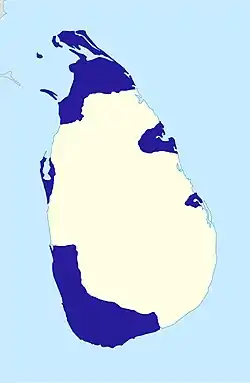Dutch Ceylon
Dutch Ceylon existed from 1640 to 1796. It is called Landesi Lankava in Sinhala.
Dutch Governorate of Ceylon Nederlands-Ceylon | |||||||||||||
|---|---|---|---|---|---|---|---|---|---|---|---|---|---|
| 1640–1796 | |||||||||||||
 Flag
 Coat of arms
| |||||||||||||
 Dutch territorial expansion in Ceylon 1690. | |||||||||||||
| Status | Governorate | ||||||||||||
| Capital | Galle Colombo | ||||||||||||
| Common languages | Sinhala, Tamil, and Dutch | ||||||||||||
| Governor | |||||||||||||
• 1640–1640 | Willem Jacobszoon Coster | ||||||||||||
• 1794–1796 | Johan van Angelbeek | ||||||||||||
| Historical era | Imperialism | ||||||||||||
• Established | 13 March 1640 | ||||||||||||
• Disestablished | 16 February 1796 | ||||||||||||
| |||||||||||||
| Today part of | |||||||||||||
In the early 17th century, Sri Lanka (which was called Ceylon at the time), was divided between the Portuguese, and several local kingdoms. The kingdoms were fighting against each other very often. Although the Portuguese were not winning the war, their rule was rather burdensome to the people of the areas they controlled. At some point, the king of Kandy asked the Dutch for help. The Dutch East India Company ran the country. Even though they managed to control large areas near the coast, they did not control the mountain areas and the Kandxan kingdom in the center of the island.[1] The Dutch interest in Ceylon was to have a stronghold against the Iberians (Spanish and Portuguese) at the time.